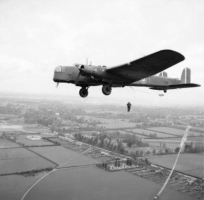It is relatively unknown that the men of No.2 Commando were Britain’s first airborne troops and the unit was the first to be designated as the Special Air Service (SAS).
In June 1940 Prime Minister Winston Churchill called for a corps of 5,000 paratroopers. Ringway, near Manchester, was identified as a suitable location, and the Central Landing School under the command of a Squadron Leader Louis Strange DSO MC DFC was established. Strange was assisted by Major John Rock of the Royal Engineers, who was tasked with the military organisation of British airborne forces.
Volunteers were soon called for, but while the recruitment process was on-going, it was decided that one of the newly formed Commando units would change to the airborne role. No.2 Commando was chosen and on 9 July 1940 the parachuting pioneers arrived at Ringway to take what was literally a jump into the unknown.
Four days later, parachute jump instructors from the Royal Air Force and Army Physical Training Corp gave a demonstration of jumping from a converted Whitley Bomber. The initial method – known as the “pull-off”- was carried out by opening the rear gunner’s turret. A small platform was installed from where the jumper would stand, pull his rip cord and wait for the deployed parachute to pull him off the back of the aircraft.
The system more suited to a stuntman on the wing of a biplane, than rapid deployment paratroopers, was soon changed. A three-foot aperture was cut in the floor of the fuselage of the Whitley and the jumpers exited the aircraft through the hole. This method allowed the paratrooper to have his ripcord pulled for him by means of a static line fixed to the inside of the fuselage.
Less than two weeks after their arrival the men on No.2 Commando made their first tentative jumps into the nearby drop zone at Tatton Park. The exhilaration of their first descents was short-lived when the first fatality occurred. Driver Evans of the Royal Army Service Corps became entangled in his rigging lines and plummeted to his death.
By November 1940 all the men in No.2 Commando had completed at least three jumps – the requirement to become a qualified parachutist. It was also in November that the unit was redesignated as the 11th Special Air Service Battalion – nearly ten months before David Stirling’s original “L” Detachment Special Air Service was formed in the desert of North Africa.
By May 1941 it was decided that a parachute brigade should be formed and the 11th SAS Battalion expanded. In September 1941 the 1st Parachute Brigade was formed under the command of Brigadier Richard Gale. The 11th SAS Battalion, consisting of the original men of No.2 Commando, was again redesignated as the 1st Parachute Battalion and became the founding fathers of The Parachute Regiment.
For more blogs by Ian McHarg click here
For books by Ian McHarg click here




Hello.This post was really fascinating, particularly because I was looking for thoughts on this topic last couple of days.